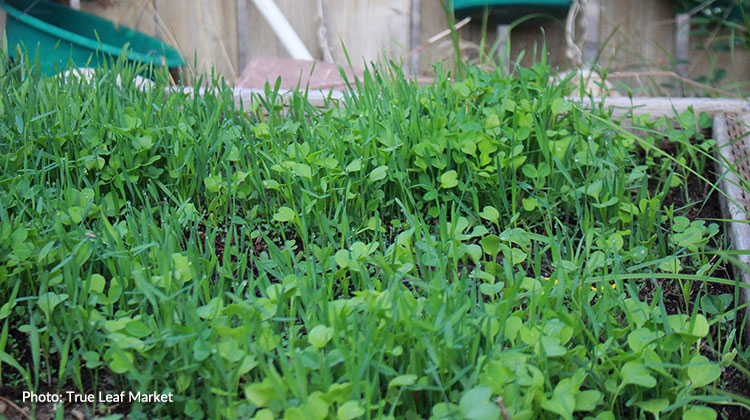
Fall Planting to Improve Your Garden Soil
Improve your garden soil with the help of fall-planted cover crops. Covering the soil with plants throughout the winter helps suppress weeds while preventing soil erosion and reducing stormwater runoff. Once the cover crop is turned into the soil or smothered and allowed to decompose in spring it adds organic matter and nutrients to the soil.
Oats, winter rye, winter wheat, crimson clover, and hairy vetch are common fall-planted cover crops. The crimson clover and hairy vetch are legumes that can add a lot of nitrogen to the soil when they decompose. Try combining these with non-legumes when possible.
True Leaf Market’s No-Till Pollinator Friendly Cover Crop Mix contains both legumes and non-legumes and helps support pollinators. Their mix contains crimson clover, hairy vetch, peas and oats.
Crimson clover is a fast grower that quickly covers the soil helping to prevent stormwater runoff. This legume like others works with soil bacteria to add nitrogen to the soil. It grows well in sun and shade.
Hairy vetch is the other legume in True Leaf Market’s Pollinator Mix. This cool season legume covers the ground protecting the soil from erosion and preventing weeds from taking over. Simply till it into the soil in spring and you’ll be adding phosphorus, potassium and nitrogen.
The peas in this mix are frost tolerant down to 10°F but die back in colder temperatures. They help add nitrogen and organic matter back into the soil.
Oats are a cool weather crop tolerating a light frost but dying back when temperatures drop below 10°F. It helps suppress weeds and its fibrous roots help soften soil. Prevent reseeding by mowing the plants to the ground in the fall if they begin to flower. Otherwise, allow the dead plants to decompose over winter.
One pound of True Leaf Market’s Pollinator Cover Crop Mix covers approximately 1,000 to 2,000 square feet, while 5 pounds covers 5,000 to 10,000 square feet and 25 pounds covers about 25,000 to 50,000 square feet.
Most cover crops go dormant over winter and resume growth in spring. Annuals like daikon radishes and oats are killed by cold winter temperatures. This makes oats a good choice if you want to get an early start to planting in spring.
Plant fall cover crops at least four weeks before the first killing frost to give them time to establish. Cereal rye is an exemption and can be planted right up to the frost. You can plant the whole garden bed or just the area between vegetables that are still growing.
Remove any weeds, plants, and mulch when planting garden beds. Loosen the soil and rake it smooth before seeding. Just remove the mulch, loosen, and rake the soil between the rows of actively growing vegetables when planting cover crops in these spaces.
You’ll need one to two pounds of seed to cover 1,000 square feet. Spread the seed over the prepared soil by hand or use a broadcast spreader and gently rake the seeds into the soil. Make spreading small seeds easier by mixing them with compost when planting. Once the seeds are planted, gently water using a fine mist.
Annual plants will be killed by cold winter temperatures, but the perennial cover crops will put on vigorous growth in late winter or early spring. Suppress this growth and kill the cover crop before it sets seed and at least two to four weeks before planting your garden. This allows microorganisms time to decompose the plant residue and avoids nitrogen deficiencies in spring plantings.
In spring use your mower or weed whip to cut the cover crop to the ground. You can till the residue into the soil at that time or cover the area with a black tarp or weed barrier for at least two weeks. Remove the tarp then incorporate the residue into the soil or plant your vegetables through the dead plant remains.
Avoid working wet soil that can result in compaction, hard as rock clods, that takes years to repair. Do a moisture test before working the soil. Grab a handful of soil and gently squeeze. If it breaks into smaller pieces with a tap of your finger, it is ready to work. If it remains in a mud ball, wait a few days.
Two weeks or more after the cover crop has been killed or tilled into the soil you can begin planting. Planting any earlier can result in nutrient deficiencies that will require a light spring fertilization.
Adding cover crops to your gardening routine will improve the soil, plant growth and is good for the environment. Like any new gardening practice, it takes time to adapt it to your space, climate, and gardening style. True Leaf Market’s Cover Crop Growing Guide can help. With time and experience, growing cover crops can soon become a part of your gardening routine.
Related
Upcoming Live Events
& Webinars
April 27, 2024
Ridges & Rivers Book Festival
Viroqua, WI
Register now
April 28, 2024
Flowering Trees and Shrubs
Ebert's Greenhouse Village, Ixonia, WI
May 1, 2024
FREE WEBINAR
Ornamental Fruits and Vegetables
Register now
May 4, 2024
Garden U 2024
New Richmond, WI
Register now
May 9, 2024
FREE WEBINAR
How to Plant Your Rain Garden
Register now
May 11, 2024
Ask The Plant Doctor Q & A
Ebert's Greenhouse Village, Ixonia, WI
May 12, 2024
Ask The Plant Doctor Q & A
Ebert's Greenhouse Village, Ixonia, WI
May 18, 2024
Ask The Plant Doctor Q & A
Ebert's Greenhouse Village, Ixonia, WI
June 1, 2024
Selecting, Planting, Pruning and Caring for Hydrangeas
Ebert's Greenhouse Village, Ixonia, WI
June 5, 2024
FREE WEBINAR
Under-Appreciated Pollinators
Register now
WATCH ON-DEMAND WEBINARS
Learn More














